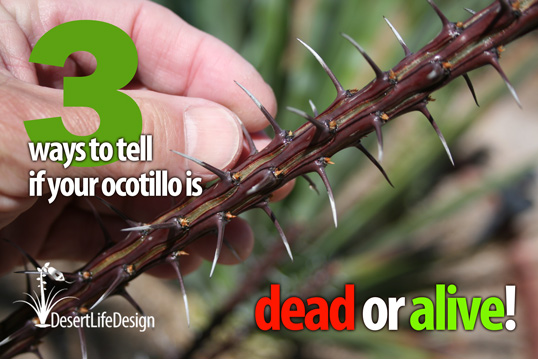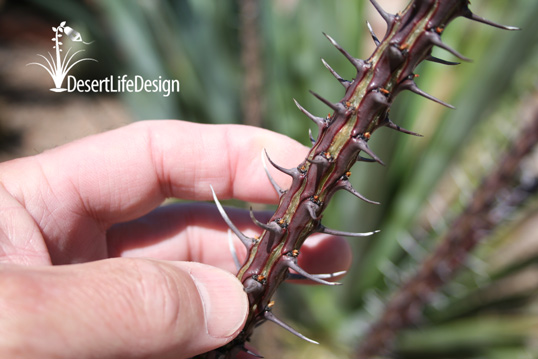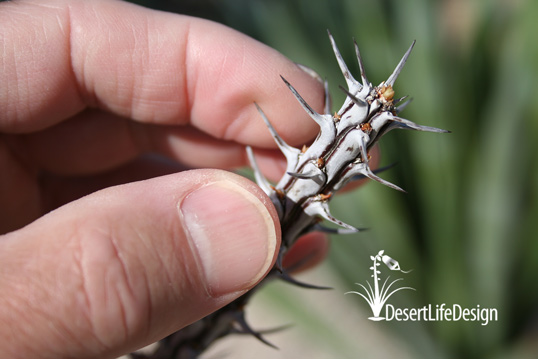3 ways to tell if your ocotillo is alive
Is your ocotillo alive?
Here in the southwestern desert at Desert Life Design, we use graphic design, photography, and creative writing to create a compelling call-to-action.

3 ways to tell if your ocotillo is alive
by Doug M. at Desert Life Design
When I first moved to New Mexico, I remember how my first ocotillo (Fouquieria splendens) looked dead soon after I had planted it! Months later, my ocotillo was a clump of brown, spiny sticks with no leaves and no flowers. Despite displaying no signs of life, I didn't give up hope. And soon, I learned how to answer this question: “Is my ocotillo dead or alive?”
3 ways to tell if your ocotillo is dead or alive?
Without leaves or flowers, any plant might appear dead. Fortunately with the ocotillo, the plant can still speak to us even when it appears dead.
1. Ocotillo stems that are alive contain a green pigment
If you look closely at the dead-looking stems or canes of your ocotillo, you should see green bands of chlorophyll (see photo below). Even when this plant has no green leaves, the ocotillo uses chlorophyll in its dead-looking stems to produce energy from photosynthesis!

That's a clever survival strategy that helps these plants survive in their harsh desert environment. So before you dig up and trash your dead-looking ocotillo, look for the sometimes subtle green bands of chlorophyll in their stems.
— Make stems wet to make the green more visible
If you look closely at the dry stems, and still don't see any hints of a green hue, try making the stems wet. That's what I did when I took these photos, and the water really makes the green pigments more apparent.
If you see green, you know your ocotillo is still alive!
— Use a knife to scratch the surface
Another way to look for the green, tell-tale sign of life-sustaining chlorophyll in your ocotillo is to scratch a branch's surface with a knife or your finger nail. Underneath the bark, you should see fleshy green tissue.
You could also use this technique to look for signs of life in any dead-looking deciduous tree or bush in your landscape.
2. Look for leaf buds
Another way to confirm life in your ocotillo is by looking closely right above each spine. That's the area where new leaf buds emerge in the spring (see photo below). The buds might even appear green.

Here in the southwestern United States, new leaf buds appear in the spring, but might also continue to regenerate throughout the summer and fall.
The buds look very similar to the buds you see on deciduous trees.
3. Bend a stem and see if it breaks
If you don't see strips of green pigment or leaf buds, try bending a stem. If the stem or cane is flexible as you bend it, then it is probably still alive.
On the other hand, if the stem snaps or breaks while you bend it, it is probably dead. However, one stem might be dead while other stems are alive.
If one stem breaks, try bending another stem to see if it also breaks. When multiple stems lose their flexibility and break when you bend them, it is probable that your entire ocotillo plant is dead.
Fortunately, though, if you find that some of your other branches are flexible, your ocotillo still has life in it!
4. (bonus) Water thoroughly and wait for leaves to appear
Finally, you could thoroughly water your ocotillo (be sure it is planted in well-draining soil). While you water, make the stems wet. The moisture on the stems, just like a desert rain, might stimulate leaf production.
With this last step, patience is the key. After you water the roots thoroughly and make the stems wet, it might take several weeks for new leaves to appear.
However, if your ocotillo is still alive, it will eventually reward you with luscious green leaves and maybe even some fiery, traffic-stopping orange-red flowers to usher in the summer of heat!

Above, a stunning flower from an ocotillo plant! Their bell-shaped flowers and bright orangish-reddish hues attract hummingbirds and other pollinators.
Writing and photographs from Doug M. at Desert Life Design! If you'd like to read more about xeriscaping your landscape, please click here.

Desert Life Design™ is based in the Phoenix, Arizona metro area. Here, we strive for perfection in graphic design and concise written communications.
